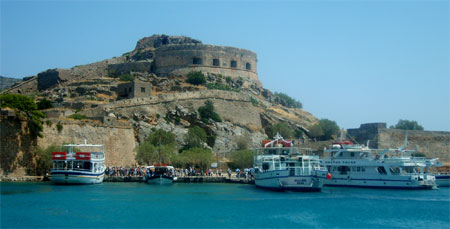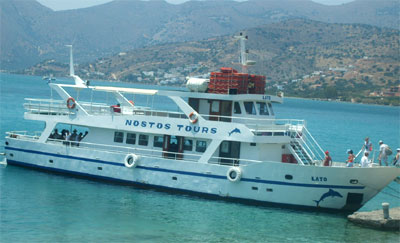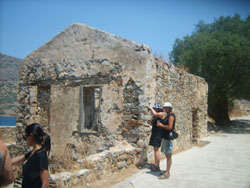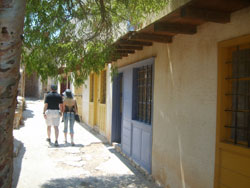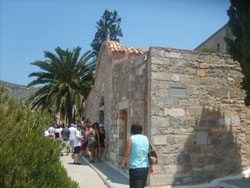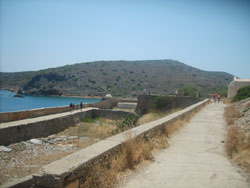|
Spinalonga Crete 2025 |
||||||
|
|
Our tip: We recommend the crossing to Spinalonga from Elounda. There are boats every 30 minutes, you can stay on Spinalonga as long as you like: More info and booking Directions to Spinalonga There are ferries and small fishing boats from Agios Nikolaos, Elounda and Plaka. All prices below are from the year 2020 or 2025. The entrance fee for Spinalonga (8 Euro) is added. The entrance fee is paid on the island Spinalonga, all prices on the internet or in travel agencies on Crete are only for the crossing, the entrance fee is always extra. Children under 18 do not pay entrance fee,
2 suggestions for good boat trips by Agios Nikolaos: The offers with reservation in advance in the Internet are often inexpensive. 1. With guide: Very good, inexpensive and with best evaluations of participants is a boat route for only 16 euro with guidance. You should book it online as it is very popular: Click here for more informtion and booking 2. With lunch: We recommend the following day tour for about 25 Euro in 2025: Click here for more informtion and booking
2. From Elounda to Spinalonga: The crossing from Elounda to Spinalonga is our recommendation. Fishing boats leave every 30 minutes during the day during the tourist season. The crossing costs 12 Euro round trip. Advantage: You can stay as long as you want. On the way back you simply take the next boat. The great wooden boats to Spinalonga depart in Elounda directly at the harbour in the centre (not to be missed). Journey time about 30 min for the easy route. Also here we recommend the purchase of the tickets before in the Internet: Click here for more informtion and booking 3. From Plaka: Plaka is a small village not far from Spinalonga. It is located 5 km north of Elounda. From here you can take the local fishermen to Spinalonga. A ticket costs 10 euros return, travel time only 5 minutes, departures about every 20 minutes. We recommend to take a boat from Elounda to Spinalonga in 2025, not from Plaka: The parking lots in Plaka are often occupied and partly chargeable. By public bus you can get to Plaka and back only a few times a day. The crossing to Spinalonga takes only 5 minutes from Plaka (less than 1 km). Thus, one does not have much of the boat trip. It costs 10 euro for the 5 min, from Elounda one is half an hour for 12 euro on the way. Also the city of Elounda is the more interesting place. The small village Plaka consists almost only of a few restaurants and souvenir shops for the tourists to Spinalonga. If you use a navigation device, you should know that there are several places in Greece and Crete called Plaka. From Agios Nikolaos it is usually best to take a direct ferry ride. However, the disadvantage is the often short stay on Spinalonga. You should ask beforehand how long you will moor - 60 minutes, how many organizers offer it, is in my opinion too little to look at everything. Who wants to stay long, takes a ship from Elounda in the morning (More info and booking). Then you can stay as long as you want.
Those who do not have a rental car and do not want to make an organized tour, simply take one of the frequent buses to Elounda from the bus station in Agios Nikolaos. Then by wooden boat from Elounda to Spinalonga (booking). There are also some buses that continue to Plaka. Possibly, however, one has the problem that one has to wait for hours for the bus on the way back from Plaka. On windy days with high waves you should know that the bay of Elounda is well protected. Thus, the crossing from Elounda or Plaka is almost always without waves. From Agios Nikolaos, on the other hand, one drives at least at the beginning on the open sea.
The best way to get to Elounda is by rental car. Some readers have told us that parking in high season can be a problem both in Elounda and especially in Plaka. The earlier you arrive in the morning, the more likely you are to get a good parking space. In Elounda there are many free parking places around the harbour. History of Spinalonga In the 15th century, the Venetians built a castle or a huge fort on Spinalonga. In 1669 the Turks conquered Crete. However, the Venetians still held the fortress Spinalonga for nearly 50 more years despite many Turkish attacks. A fort with such thick walls was practically impregnable at this time. Until the Turks finally left Crete around 1900, the mighty castle served as a residential area for Turkish settlers.
After this, the famous time of Spinalonga began: The leper colony, All the inhabitants of Crete, who were suffering from leprosy, were banished to Spinalonga. At this time (about 1900-1950), leprosy was a dangerous and incurable disease. Nobody could be cured - so the lepers of Spinalonga expected a lifelong stay. There were up to a 1,000 patients on the island, which is separated from Crete by only a few hundred meters. Around 1953 the first effective therapies were found. About eight years later the Leprastation Spinalonga was closed. Many of the inhabitants were able to leave the "leprosy island" cured. Visit of Spinalonga The houses, the hospital, the church, etc. of the leper colony still exist and can be visited. You arrive by boat in the south of the island Spinalonga. The circular route around the island is about 1.5 km long. After a few meters you reach the residential settlements. Some of the houses have been restored. There is a interesting photo exhibition and an information office.
The small church was renovated a few years ago. Interesting is the disinfection room. Some people could visit their sick relatives on Spinalonga. They were disinfected with an acid when they left the island. You should also visit the hospital and the cemetery.
For many visitors the ascent to the big venetian fort is the highlight. Be careful, the path can be slippery. From the top you have a great view. You can see Plaka, Elounda and the entire area.
At the end of the island tour is a simple snack bar. Here you can get water, cola, sweets etc., quite expensive. In front of the only toilet on the island Spinalonga there is often a long queue. Also on the small ferries of Elounda and Plaka there is no toilet.
The author: My name is Jorgy. I am German and I have been living in Crete for more than 10 years. I translated this article from German into English. I am not a native English speaker.
|
|||||
